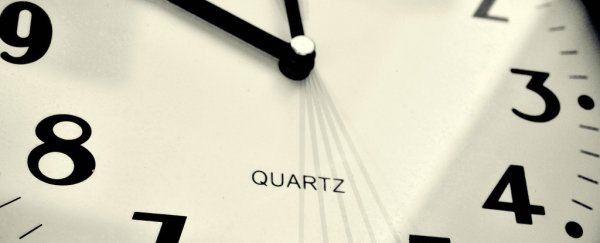We all know time is a construct, and right now, it's kept by the very precise tick of an international network of around 500 atomic clocks.
But now researchers have shown that time could be kept even more accurately with a new-generation of clocks called optical clocks, and they want to use the new system to redefine a second - which would mean we could squeeze even more into our days.
The optical clock they've just measured is so precise that it would have lost less than two minutes if it had been running since the birth of the Universe, which is pretty incredible once you wrap your head around it.
Global time-keeping is important, because 'the second' - as defined by the International System of Units (SI) - is what our GPS devices, electrical power grids, and financial networks all rely on.
That's why we use atomic - or microwave - clocks, which measure the vibration of a caesium atom to keep time, just like the tiny swinging of a pendulum. And since 1967, a SI second has been defined as 9,192,631,770 cycles of those vibrations.
But, as specific as that sounds, even the best atomic clocks can still accumulate an error of about 1 nanosecond over a month.
Optical clocks, on the other hand, are even more precise. They work similarly to atomic clocks, but they measure the oscillations of atoms or ions that vibrate at frequencies about 100,000 times higher than microwave frequencies - which is a whole lot faster, and therefore more accurate.
That accuracy comes with some cons though - more complexity and therefore more downtime - which means anything from a few minutes where the optical clocks can't tell time up to two days. And because of that, until recently, they hadn't been considered a viable option for redefining the second and keeping global time.
But the new research describes a system that could actually work.
"We showed that even with the downtimes of today's optical clocks, they still can improve timekeeping," said one of the researchers, Christian Grebing, from the National Metrology Institute of Germany. "We achieved a better performance compared to the very best microwave fountain clocks which have generally been considered less reliable and thus less suitable for the actual implementation of a practical timescale."
To compensate for the downtimes of today's optical clocks, the researchers combined a commercially available atomic clock device called a maser with a strontium optical lattice clock. The maser isn't as accurate, but it worked to cover the downtime of optical clocks.
Obviously, there was still a big gap between the accuracy of the two clocks, but the team overcame that by using an optical frequency comb, which divides the slower optical-based 'tick' to match the faster 'ticks' of the optical clocks.
"We compared the continuously running maser with our optical clock and corrected the maser frequency as long as we had data available from the optical clock," said Grebing. "During the optical clock's downtimes, the maser runs on its own stably."
The team ran the clock system for 25 days, and the optical clock ran about half the time. Even with downtime of up to two days, they found that the time error was less than 0.20 nanoseconds over the 25 days.
In other words, they would only lose 100 seconds over the age of the Universe - about 14 billion years. That's around 100 times better than atomic clocks.
"Our study is a milestone in terms of practical implementation of optical clocks," said Grebing. "The message is that we could today implement these optical clocks into the time-keeping infrastructure that we have now, and we would gain."
That gain is the ability to squeeze more into every second. Us slow humans wouldn't really notice, but things like financial time stamps would be more specific ,and banks would be able to complete even more transactions per second.
As cool as that is, Grebing says it'll be about a decade until we can truly redefine the SI second, because we need to look into all the available types of optical clocks and assessing which is the best one to move forward with.
"We want to improve the timekeeping infrastructure all over the world by building better and better clocks and integrating them into the time-keeping infrastructure," said Grebing. "What we demonstrated is a first step towards a global improvement of time-keeping."
The research has been published in Optica.
